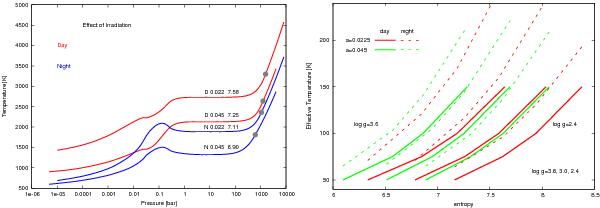Fig. 3

Left: the effect of the planet-star distance (a magnitude of irradiation) on the T − P profile of the atmosphere. Red lines represent the day side, blue lines represent the night side. Circles mark the top of the convection zone. D-stands for day, N-stands for night, numbers give the planet-star distance in AU and the core entropy, respectively. Notice that entropy on both day and night sides increases with increasing irradiation (shorter distance). Right: the effect of the planet-star distance or irradiation on the day-night side cooling of the planet. The cooling is expressed as the intrinsic effective temperature in K as a function of the core entropy for several surface gravities. The day-side is solid, and night-side is dashed. The models are calculated for two planet-star distances 0.045 (green) and 0.0225 AU (red). The cooling from the day side decreases with the stellar irradiation (shorter distance). The cooling from the night side behaves in a similar way. Consequently, the total heat loss is lower at a higher irradiation.
Current usage metrics show cumulative count of Article Views (full-text article views including HTML views, PDF and ePub downloads, according to the available data) and Abstracts Views on Vision4Press platform.
Data correspond to usage on the plateform after 2015. The current usage metrics is available 48-96 hours after online publication and is updated daily on week days.
Initial download of the metrics may take a while.




